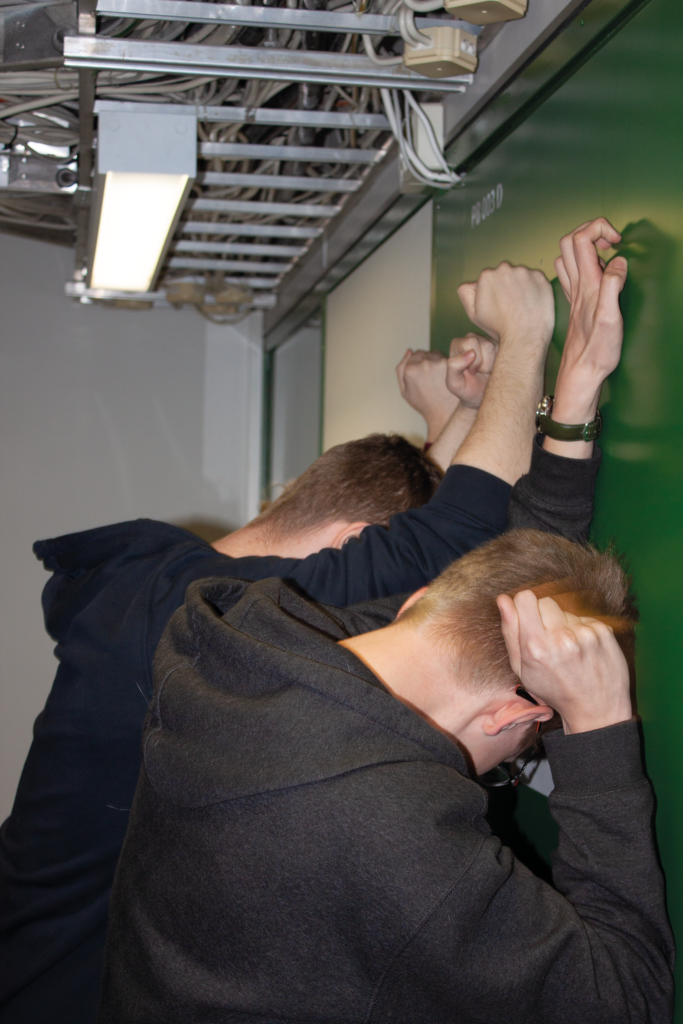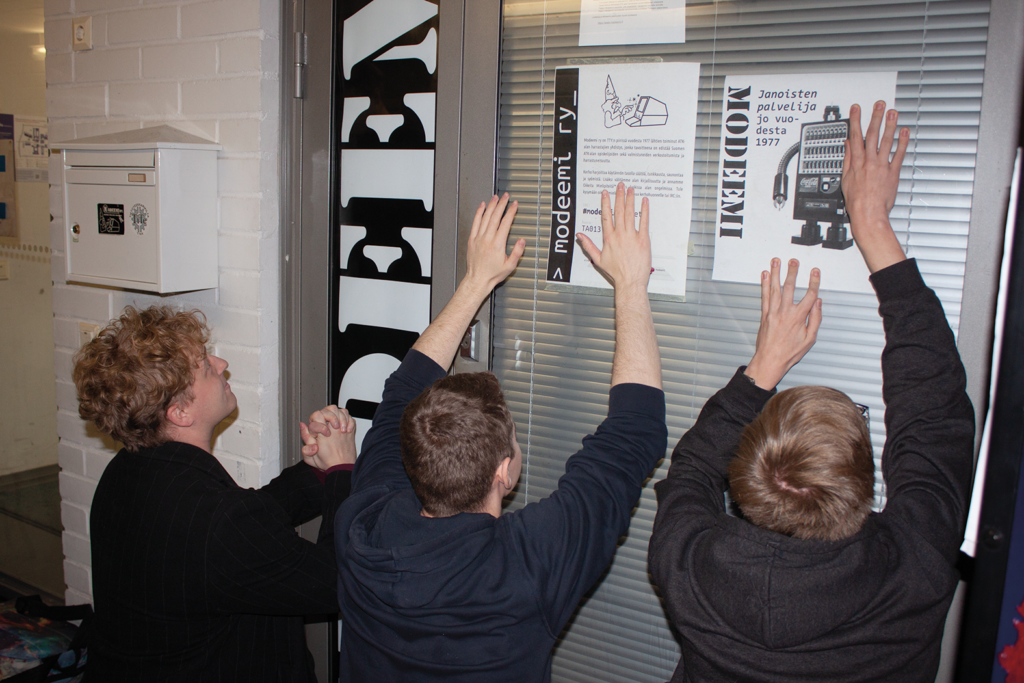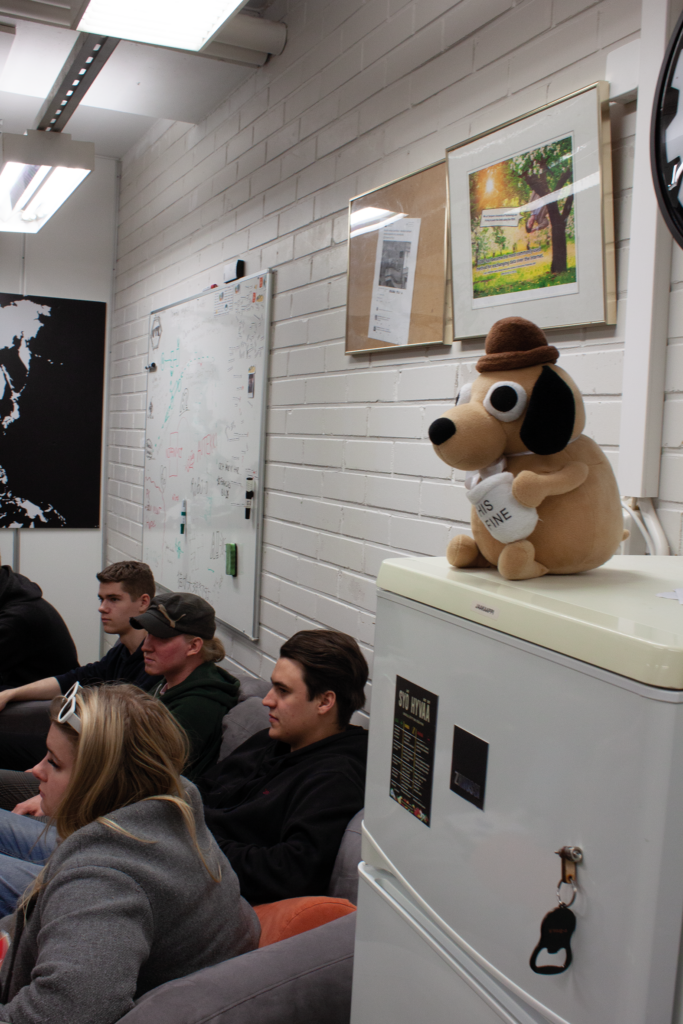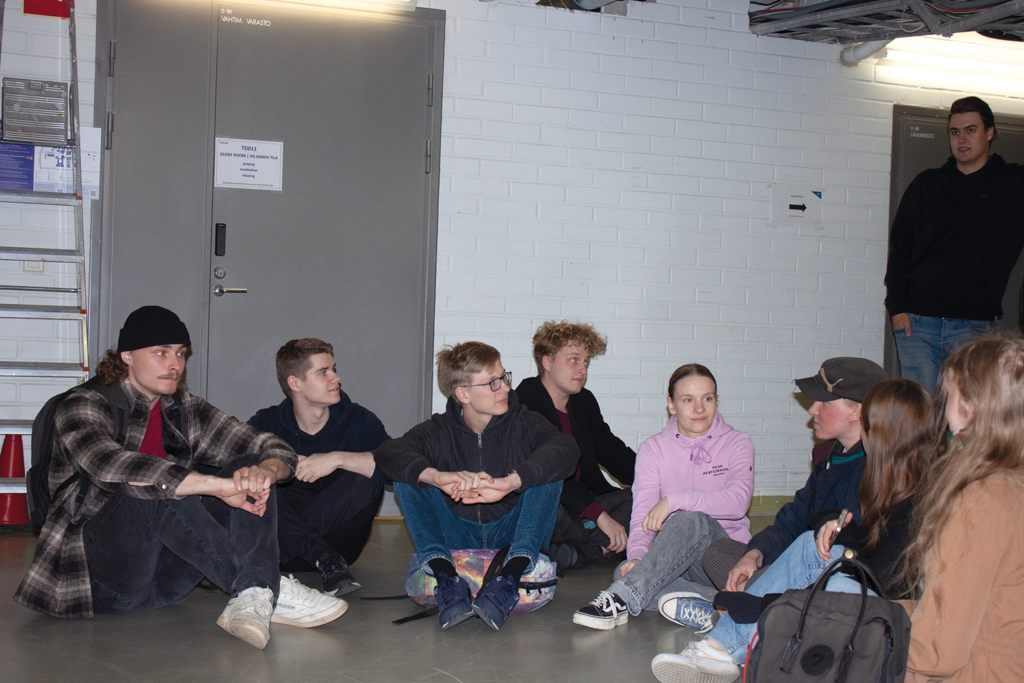All work and no guild rooms make Jack a dull boy – guilds and hobby associations are looking for facilities but the process is long and complicated
At Hervanta campus, issues with facilities are once again raising eyebrows and causing problems. New guilds Robo and Emu have started their activities during the autumn without guild rooms and there does not seem to be enough space for hobby associations either. The situation is further complicated by future renovations and space reductions.
Original text and pictures: Silja Kinnunen
Translation: Kiia Saarenpää

Artikkeli on luettavissa myös suomeksi.
The new robotics guild Robo has applied for a guild room for over a year with no success. New freshers have already been welcomed and activities have started in the new degree programme, but the guild room application is still pending.
During the spring they almost succeeded. The former communications brand renewal warehouse TD011 from Tietotalo was proposed to be the guild room for Robo.
At the same time, however, the logistics administration space was moved elsewhere from Sähkötalo to the basement of the Main building, where INTO’s rental service and the quiet room had operated before. The quiet room was also used as a prayer room. This quiet room was moved to the communications warehouse that Robo was after since a water point was needed. TD011 has been used as a prayer room since 3rd of July but its sink is not suitable for washing feet. People have to wash their feet in the bathrooms next to the guild rooms causing puddles in both the bathrooms and hallways. In the end, the new prayer room is also underused, and the arrangement has most likely been a disappointment to all parties involved.
According to the Chair of Robo Leevi Kukkonen, the arrangement was made without actually informing anyone, and the space that was excellently suited as a guild room now appears to many as an unused and useless space.
”When I was filling in the application, I knew that this would be a long process, and I was prepared to wait for approximately two years. However, this arrangement does not seem to make sense, and it would be nice to have more communication”, Kukkonen says.
An inventory should be made of all the campus facilities and spaces because the current use of the spaces does not make sense.
According to Kukkonen, an essential part of running guild activities is missing when there is no guild room available. Currently, freshers are temporarily allowed to hang out in the Pullonkaula, the room of the modern production technology subject club. The next options for the guild room could be Bioner’s guild room in Main Building, if Bioner moves to a bigger space after the renovation of Sähkötalo. The intake of Bioner has risen year after year, and the current facilities are too small.
The Bioner case also shows the future space problems in general: there is a constant desire to increase the intake of students, but even now some of the guild rooms are too small compared to the number of users.
”When Festia is removed from use, there really isn’t much space left after that”, Kukkonen adds.
For example, Autek has applied for more space for their storage room, but this was not okay with the university and the facility services. According to Kukkonen, the decision has been justified by the same argument that the storage facilities in the main building have not been given for the students to use: without proper ventilation, the premises may not be taken into use.
”However, there is no ventilation in the INTO guild room and apparently that has not been a problem.”
According to Kukkonen, an inventory should be made of all the campus facilities and spaces because the current use of the spaces does not make sense. For example, the Main building basement has many storage rooms that are underused, as well as a meeting room that the staff hardly want to use. After all, there are good meeting rooms elsewhere apart from the basement that are not in the vicinity of noisy guild rooms. Optimisation will become necessary anyway as the spaces are reduced even further.
Also, the new guild for students of energy transition EMU has started its operations in the autumn without a guild room, and the guild board plans to invest in getting a guild room after the schedule has calmed down a bit after all the fresher events.

No one really knows what is happening
According to Aaro Haikonen a board member of TREY, the Student Union of the University of Tampere TREY has searched the campus for empty spaces for potential student use, but the processes are long and complex.
”There are a lot of large campus development projects currently underway in Hervanta, and they affect the distribution of facilities. In particular, the renovation and demolition projects of Sähkötalo will affect the campus facilities in their entirety”, says Haikonen.
Even though there are no guild and club rooms at the moment, the situation is not getting any easier. According to the university’s campus development plans, facilities are being reduced from, for example, Konetalo and Festia. Next year, the renovation of Sähkötalo will force all associations using Skellari to evacuate, but no new facilities have yet been identified.
”I don’t think the situation is clear to anyone right now. In TREY’s office, we have some idea about the situation, but there is some confusion in the university’s end, which complicates our own operations. Information is not moving”, says Haikonen.
Haikonen specifies that there seems to be ambiguities between campus development, facilities services, and the university, but it is possible that internal parties know their role better than it would seem externally. TREY is not able to give clear, confirmed answers to students because of the uncertainty of the situation. Frustrated feedback has been received from students on the slowness of the process, and Haikonen believes that this may be partly due to the fact that the extent of the process chain is not visible from the outside.
Changing the purpose of the facilities is also not a simple or quick process. Moving the facilities is one long domino effect, which is evident from the Robo case.

The distribution system needs fixing and fast
Other associations and clubs are also looking for facilities on campus. Arts and crafts club Tahra has been on the waiting list for a long time and a space was already planned for the club from Sähkötalo, but in the final facility decision it did not get a space of its own after all. According to the club, they had no information about the plans or the meetings, where they could have influenced the decisions.
Tahra is looking for a facility where members could work on their arts and crafts projects and also meet up on a weekly basis. If the club got its own clubroom, artwork could also be presented there, and supplies could be stored in it. All the supplies currently reside in one board member’s own cage storage room.
According to Tahra’s Chair, Vilma Piitulainen, the board members of the club feel that getting a club room has been difficult for Tahra, since it is still small and quite new as a club, and it has not been able to establish its activities in the community yet.
”We are not familiar with the club room application process, and we have no idea, how we could have a say in the process”, says Piitulainen in an e-mail.
”We find it problematic that the information about the facility plans did reach the club except through hearsay. We hope that TREY would pass information to the clubs more effectively when decisions are made about the facilities. It felt strange that people were having discussions about the possible facilities our club could have but we weren’t even aware of this.”
According to Aaro Haikonen, the distribution of club facilities operates on a queuing system, which was outlined by TREY’s first Executive Board in 2019 as a decision in principle. The associations queue for the facilities and as a rule, the facilities are given out from the requested campuses, prioritising subject, and advocacy associations.
Moving the facilities is one long domino effect.
Other associations, such as hobby associations, which invitational clubs are also included in, are equal and receive a facility in the order the applications were sent. Currently, the rules do not allow for open clubs to be prioritised over closed ones. However, the lack of prioritization has caused a stir, as in the end, only very few students are admitted to the invitational clubs, and especially after the covid-19, many open clubs would need space to create interest in their club and develop their activities.
This is also the opinion of the student active Tupsu Simisker, who is the Chair of the Association for Signal Processing and Telecommunications Electronics TeLE ry. In the autumn of 2021, after previous discussions, TeLE was given a time limit at the very last minute to move out of its big club room in Skellari, out of the way of Elram and NMKSV.
Fortunately, the new space was obtained from Tietotalo’s basement next to TiTe, a space shared with Computer Club Modeemi, but it is cramped and affects the development of activities of the club, according to Simisker. The timing for the move could not have been worse, as after several years of silence and a covid-19 pandemic, the club had just gathered a motivated board that wanted to develop the club’s activities. All this energy had to be directed at moving the club to a different facility.
Simisker understands that invitational clubs play a big role in maintaining the teekkari culture, and the clubs had been waiting for their own space for a long time, but prioritization would still be needed.
”This is a value judgement from the Student Union. In addition, the decisions are influenced by the fact that many student actives are the ones making the decisions on these issues. So, who should oversee these issues so that the decisions are as neutral as possible?”

There just is not enough space available
One of the major problems with the issues at hand have to do with the lack of clear and reachable communication. According to Simisker, not having enough information and poor reach of communication lead to fear and panic. Many actives are stressed by the upcoming renovation of the Sähkötalo when there is still no information on where the guilds will move to.
The transfer of 15 associations from Skellari will not be a simple project. Telok, Albatross and Euroavia have been a challenge for architects with their instruments and special needs, but fortunately cooperation has been possible. At the moment, the plans for the Sähkötalo building are almost ready and they have been made in agreement with the clubs. The building permit is scheduled to be submitted in October.
The common opinion of the students that were interviewed clearly seems to be that there are not enough guild and club spaces, and some of them are too small for their users. Students hope for a more optimal and rational sharing and use of the facilities, which has been a wish with the study and teaching facilities, too.
According to Taina Vimpari, Development Manager of Facilities and Real Estate Services, the guild facilities of Sähkötalo will undergo renovation at the beginning of 2025, and the renovation is expected to take about six months. According to Vimpari, alternative spaces have been considered, but the matter has not yet been discussed with TREY or the guilds. Visiiri was not able to contact Vimpari about the facility matters, even after trying to contact Vimpari multiple times.